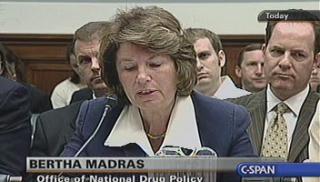June 17 From Jordan Tishler, MD, in response to the item we posted yesterday about an op-ed in JAMA detailing the practice standards that the Federation of State Medical Boards expects cannabis clinicians to meet.
I read the OpEd in JAMA yesterday with some trepidation, but was relieved to see that their recommendations were appropriate to a basic standard of care observed throughout Medicine. If we, as specialists, wish to be regarded as valued member of the greater Medical community, we must operate within those accepted norms. The only problem that I see with these recommendations is that they ought to be required of all SCC members and we (the SCC) should have instituted them first, before they were handed down from non-expert sources.
Jordan Tishler MD
Inhale MD Health & Wellness
www.inhalemd.com
617.477.8886 (voice and fax)
FG responds: I strongly agree that the SCC should have beaten the Federation of State Medical Boards to the punch. In fact, we did —but way too many years before they might have been receptive. SCC founder Tod Mikuriya, MD, and charter member Frank Lucido, MD, had allies in the California Medical Assocation and they succeeded in 2003 getting a resolution passed that mirrored SCC practice standards. I’ll put the relevant reports from O’Shaughnessy’s online.
June 17 From Dr. Greg Gerdeman, who notes that the guidelines being proposed for state medical boards restrict doctors’ investment options and asks:
Is there any similar restriction on physicians owning stock in pharmaceutical companies if they are prescribing their products? I know that the pharma-doctor relationship is much stricter nowadays in terms of “free lunches” and other giveaway incentives, and that for example, many of the pharma companies now require clinical conferences to involve real education and a full workday as a condition for sponsorship dollars. I think there’s a tip of the hat due to Ralph Nader and Public Citizen for those changes, among others. But to my knowledge there is no standard of ethics that says a physician shouldn’t own shares in a drug company… Or shouldn’t themselves be taking prescribed Xanax if they are engaged in the practice of medicine.
The guidelines in the JAMA piece suggest that doctors should not consume cannabis themselves if they are to be engaged in an active practice. What if the doctor uses it for chronic pain or Crohn’s Disease, etc? Is the idea that medicine is too important to compromise by being a pot smoker? Or is it that a pot-smoking doctor might lose objectivity? Why should doctors themselves stay away from cannabis if there are legitimate reasons for using it? Thoughts?
FG: Because it’s the devil weed, Greg. It’s so dangerous it needs to be tracked from seed to sale, even under so-called “legalization.” The set of med board guidelines written up in JAMA —and the coming regulations in California and elsewhere— are based on the assumption that cannabis is a very harmful drug. Which it is by definition, being on Schedule I, and would be by definition on Schedule 2 (the only difference being sked 2 drugs can have medical use). Doctors who approve cannabis use by patients cannot be users themselves in Colorado. We know one would-be cannabis specialist in Denver —a medical user— who has stayed on the sidelines professionally for that reason… Dr. Goldstrich should tell us about the situation in Colorado at the upcoming meeting. And the SCC should consider pushing for descheduling at the state level (as proposed by Bernie Sanders at the federal level).
The regulatory authorities can no longer deny the reality of benefit —not because 2 million Americans report medical benefit, but because the clinical trial of Epidiolex in the treatment of Dravet Syndrome was randomized, blinded, and placebo controlled. All they’ve got left is harm. Not just prohibition rests on marijuana causing harm, so does the whole bureaucratic tax grab called “legalization.” If cannabis wasn’t harmful, why would “seed-to-sale” tracking be needed (and what role could Microsoft play)? Why should users have to pay such high taxes? The regulators don’t need to allege harm on the scale Harry Anslinger warned about, all they need is a 9% addiction rate and damage to the developing brain. These neo-prohibtionists can make a little harm go a long way (as in homeopathy). It can justify an ongoing role for law enforcers and regulators and mandatory “treatment” for marijuana users.
The neo-probes are waging a systematic campaign to remind us that marijuana is addictive and harmful. Just today the Toronto Star ran an excercise in sophistry called “The Case for Prescription-only Marijuana” by a man named Colin Dormuth (Not a doctor who sees patients, BTW; he analyzes data.) Dormuth writes:
One argument I have heard is that marijuana is harmless. This argument ignores the fact that numerous studies have reported harms in peer-reviewed academic journals. A summary of the evidence, published in the New England Journal of Medicine in 2014, concluded, “Marijuana use has been associated with substantial adverse effects, some of which have been determined with a high level of confidence.” Some of those effects were addiction to marijuana and other substances, motor vehicle accidents, and chronic bronchitis.
Other effects were reported with either high or medium confidence. Some of the medium-confidence effects were schizophrenia and abnormal brain development in young people. In order to believe the harmless argument, you have to believe that all of the studies reporting harms were wrong.
Addiction is the first and foremost harm attributed to devil weed lite —an allegation debunked in the current O’Shaughnessy’s. We also cite a suppressed study questioning the evidence that marijuana use leads to “abnormal brain development in young people.” In an earlier issue we ran Lester Grinspoon’s discussion of marijuana and schizophrenia. Of the “substantial adverse effects” cited by Dormuth, only bronchitis is valid —and it doesn’t proceed to COPD, Donald Tashkin has determined conclusively. Dormuth’s “harmless argument” is a straw man. No serious proponent of cannabis as medicine denies it might cause bronchitis and exert other adverse effects. But they are relatively mild compared to those lists of adverse effects you hear an announcer speed-rapping at the end of pharmaceutical commercials on TV. The point, as Dr. Mikuriya used to phrase it, is that cannabis has “a relatively benign side-effect profile.”
June 17 An Exchange With Sunil Aggarwal, MD, who commented re the med board guidelines: “At least they said docs can toke on their own time —that’s a big step forward.”
FG: Is that how you read it?
Aggarwal: The last line says ‘Don’t be under the influence’ when working.
FG: But what if a med board defines under-the-influence in terms of metabolites in the urine? I read this document as menacingly vague, not reassuring. But then again I’m a “glass-is-half-empty” guy.
Aggarwal: It’s got plenty of “mays” in there. Also “actively engaged in the practice of medicine” —the active bit is noteworthy. And practicing “under the influence” —if med boards said metabolites are the deciding factor, they can only judge recency of use and not impairment level, so it could be fightable. They can always be asses, but I think there is a relaxation of zero tolerance here.
FG: The problem is ‘fightable.’ It means the accused MD has to go through a costly, time-consuming ordeal —being investigated, hiring a lawyer, and having to defend him or herself before an Administrative Law Judge. Maybe the SCC should evaluate these looming guidelines point-by-point at our June 19 meeting. And then relay our assessment to the Medical Board of California in hopes of revising them, if the group thinks revision is called for.





